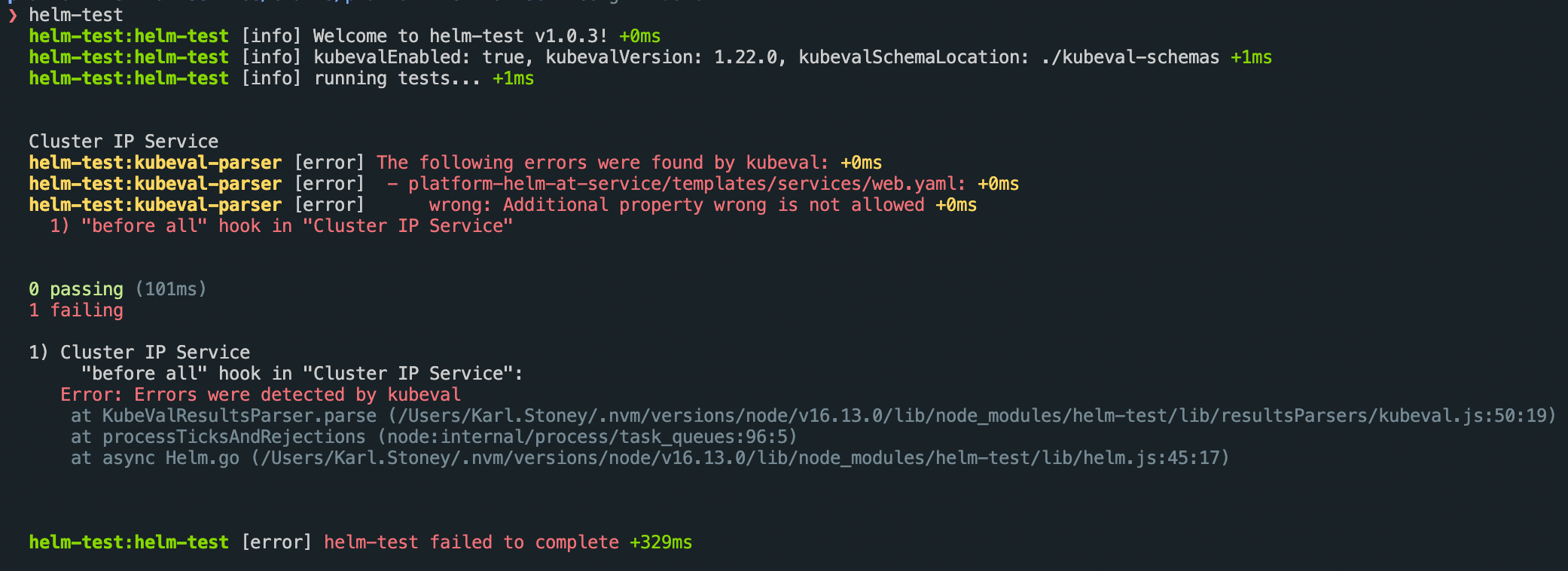helm-test v1.4.2
helm-test
Mocha based testing for Helm packages!

What does it do?
Helm is a great tool for packaging and templating your kubernetes definitions. However as your templates grow in complexity, and you start to introduce conditionals and other logic it becomes increasingly easy to unwittingly break them.
I wanted to take some of the tooling that I use when coding, and create a simple cli to test the manifest files that helm generates. helm-test will run helm to generate your manifests and then parse the results into JSON for you to perform assertions against.
As of version 1.0.0, you can also opt to run your manifests through kubeval.
As of version 1.1.0, you can also opt to run your manifests through istioctl.
How to use it
Installation
helm-test is distributed as a command line interface, simply type npm install -g helm-test.
I assume you've got helm downloaded as you're wanting to write tests on helm charts, but if you don't, then - download helm, and ensure it's available on your path.
As of version 1.0.0, only helm3 is supported.
Kubeval
You can have helm-test run your manifests through kubeval for some additional checking. By default kubeval will attempt to download the schemas, but if you have lots of tests then I strongly suggest downloading a copy of the schemas you are interested in:
mkdir -p /tmp/kubeval-schemas
curl https://codeload.github.com/yannh/kubernetes-json-schema/tar.gz/master |
tar -C /tmp/kubeval-schemas --strip-components=1 -xzf - \
kubernetes-json-schema-master/v1.22.0-standalone-strictThen you can enable kubeval in helm-test:
export HELM_TEST_KUBEVAL_ENABLED=true
export HELM_TEST_KUBEVAL_KUBERNETES_VERSION=1.22.0
export KUBEVAL_SCHEMA_LOCATION=/tmp/kubeval-schemasIf you plan on running kubeval too, make sure you've downloaded that too and it's accessible on your path.
Whenever you call helm.go() in your tests, the templated manifests will also be passed through kubeval:

IstioCTL
If you are an istio user, you can ask helm-test to run your manifests through istioctl validate as well.
Make sure you've downloaded the istioctl binary and it's available on your path.
Then enable the feature in helm-test:
export HELM_TEST_ISTIOCTL_ENABLED=true
Writing tests
Tests should be placed in the root of your helm chart, in a tests/ folder like so:
/
Chart.yaml
values.yaml
charts/
templates/
tests/
your-tests.js
some-more-tests.jsYour test specification follows the popular Mocha layout. You can see an example here
There are some global helper variables defined for use in your tests:
helm
This is the root context and exposes the following functions:
withValueFile(path): Specify a value file to use when running helm, relative to the root of your chart. You can call this multiple timesset(key, value): Allows you to override a specific value, for exampleset('service.port', '80')would do--set service.port=80when running helmgo(done): Run a helm template generation and parse the output
yaml
This global helper function allows you to parse yaml using js-yaml. This is useful for scenarios like a configmap containing a string block which sub contains yaml, that you wish to assert on.
eg.
const json = yaml.load(results.ofType('ConfigMap')[0].spec.data);
json.metadata.name.should.eql('some-manifest');results
After running helm.go, the results variable will be populated, and it exposes the following:
length: The number of manifest filesofType(type): Get all manifests of a given type
Running your tests
Is a simple as doing helm-test:
❯ helm-test
helm-test [info] Welcome to helm-test v0.1.6! +0ms
helm-test [info] Testing... +0ms
Helm Chart
✓ should have three manifests
The Service
✓ should have standard labels
✓ should have valid metadata.name
✓ should be a LoadBalancer
✓ should be on an internal ip
✓ should have a single http-web port
✓ should select the right pods
The StatefulSet
✓ should have the right name
✓ should have standard labels
✓ should have a serviceName
✓ should have a single replica
✓ should be a RollingUpdate strategy
✓ should have matching matchLabels and template labels
Containers
✓ should have two containers
Master
✓ should use the right image
✓ should limit 2gig of ram
✓ should limit 1.8 CPU
✓ should have a http-web port
The ConfigMap
✓ should have standard labels
✓ should have valid metadata
✓ should have a docker-host key
21 passing (123ms)
helm-test [info] Complete. +443msConstantly running tests and watching for changes
You can have helm-test run every time it detects a change in your chart by simply doing helm-test --watch
Running in parallel
You can get significant improvements in performance by using mochas --parallel by doing helm-test --parallel. Please note that .only will not work.
Please also note that this will use NCPU-1 for threads, if you're also using istioctl and kubeval, that can spawn a lot of sub processes!
Failing fast
By default, all tests will run and then report back. You can fail on the first test failure by doing helm-test --bail.
Debugging
Set export LOG_LEVEL=debug to see more info about what helm-test is doing.
License
Copyright (c) 2022 Karl Stoney Licensed under the MIT license.
2 years ago
2 years ago
2 years ago
3 years ago
3 years ago
3 years ago
4 years ago
4 years ago
4 years ago
4 years ago
4 years ago
4 years ago
4 years ago
4 years ago
4 years ago
4 years ago
4 years ago
4 years ago
4 years ago
4 years ago
3 years ago
4 years ago
4 years ago
4 years ago
4 years ago
4 years ago
5 years ago
5 years ago
5 years ago
5 years ago
5 years ago
5 years ago
5 years ago
5 years ago
5 years ago
5 years ago
7 years ago
7 years ago
7 years ago
7 years ago
7 years ago
7 years ago
7 years ago
7 years ago
8 years ago
8 years ago
8 years ago
8 years ago
8 years ago
8 years ago
8 years ago
8 years ago
8 years ago
8 years ago
8 years ago
8 years ago
8 years ago
8 years ago